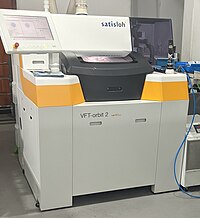
Photo from wikipedia
The interaction between light and matter remains a central topic in modern physics despite decades of intensive research. Coupling an isolated emitter to a single mode of the electromagnetic field… Click to show full abstract
The interaction between light and matter remains a central topic in modern physics despite decades of intensive research. Coupling an isolated emitter to a single mode of the electromagnetic field is now routinely achieved in the laboratory, and standard quantum optics provides a complete toolbox for describing such a setup. Current efforts aim to go further and explore the coherent dynamics of systems containing an emitter coupled to several electromagnetic degrees of freedom. Recently, ultrastrong coupling to a transmission line has been achieved where the emitter resonance broadens to a significant fraction of its frequency, and hybridizes with a continuum of electromagnetic (EM) modes. In this work we gain significantly improved control over this regime. We do so by combining the simplicity and robustness of a transmon qubit and a bespoke EM environment with a high density of discrete modes, hosted inside a superconducting metamaterial. This produces a unique device in which the hybridisation between the qubit and many modes (up to ten in the current device) of its environment can be monitored directly. Moreover the frequency and broadening of the qubit resonance can be tuned independently of each other in situ. We experimentally demonstrate that our device combines this tunability with ultrastrong coupling and a qubit nonlinearity comparable to the other relevant energy scales in the system. We also develop a quantitative theoretical description that does not contain any phenomenological parameters and that accurately takes into account vacuum fluctuations of our large scale quantum circuit in the regime of ultrastrong coupling and intermediate non-linearity. The demonstration of this new platform combined with a quantitative modelling brings closer the prospect of experimentally studying many-body effects in quantum optics. A limitation of the current device is the intermediate nonlinearity of the qubit. Pushing it further will induce fully developed many-body effects, such as a giant Lamb shift or nonclassical states of multimode optical fields. Observing such effects would establish interesting links between quantum optics and the physics of quantum impuritiesSuperconducting circuits: A firm grip on ultrastrong couplingA metamaterial made from thousands of superconducting devices provides a configurable ultra-strongly coupled environment for qubits. An already achievable application of prospective quantum computing platforms is as bespoke simulators of difficult-to-solve theoretical models. Javier Puertas-Martínez and colleagues from Institut Néel in France and the University of the Witwatersrand in South Africa have designed a superconducting circuit that provides an idealised synthetic environment for qubits with an interaction strength that is tunable with an external magnetic field. Made from a one-dimensional chain of 4700 SQUIDs, their device overcomes physical limitations on the coupling between a qubit and the natural environment, reaching the ultra-strong regime where quantum many-body effects become relevant. Integration of the design in more complicated circuits will enable the study of previously-inaccessible many-body quantum optics phenomena.
Journal Title: npj Quantum Information
Year Published: 2019
Link to full text (if available)
Share on Social Media: Sign Up to like & get
recommendations!